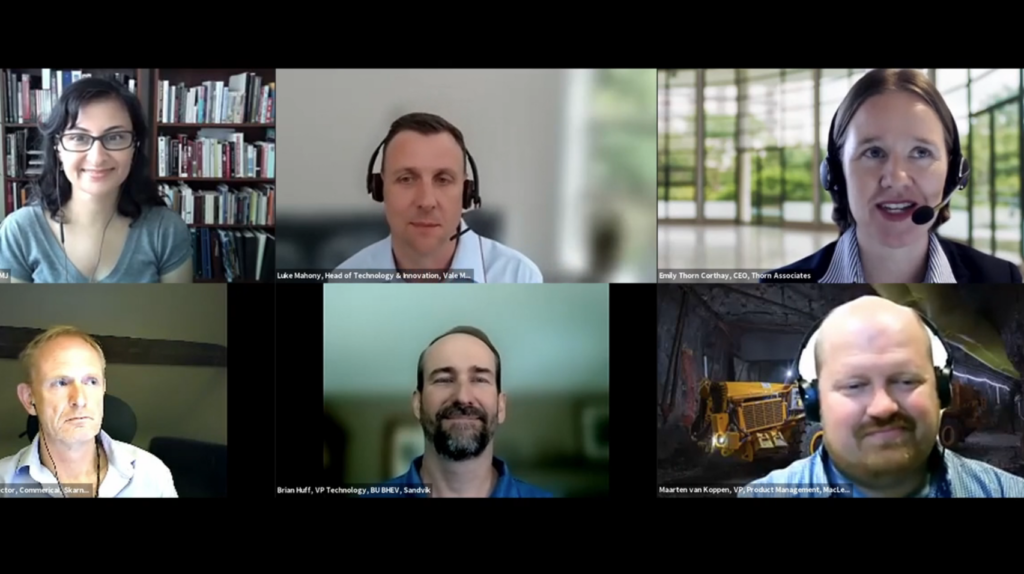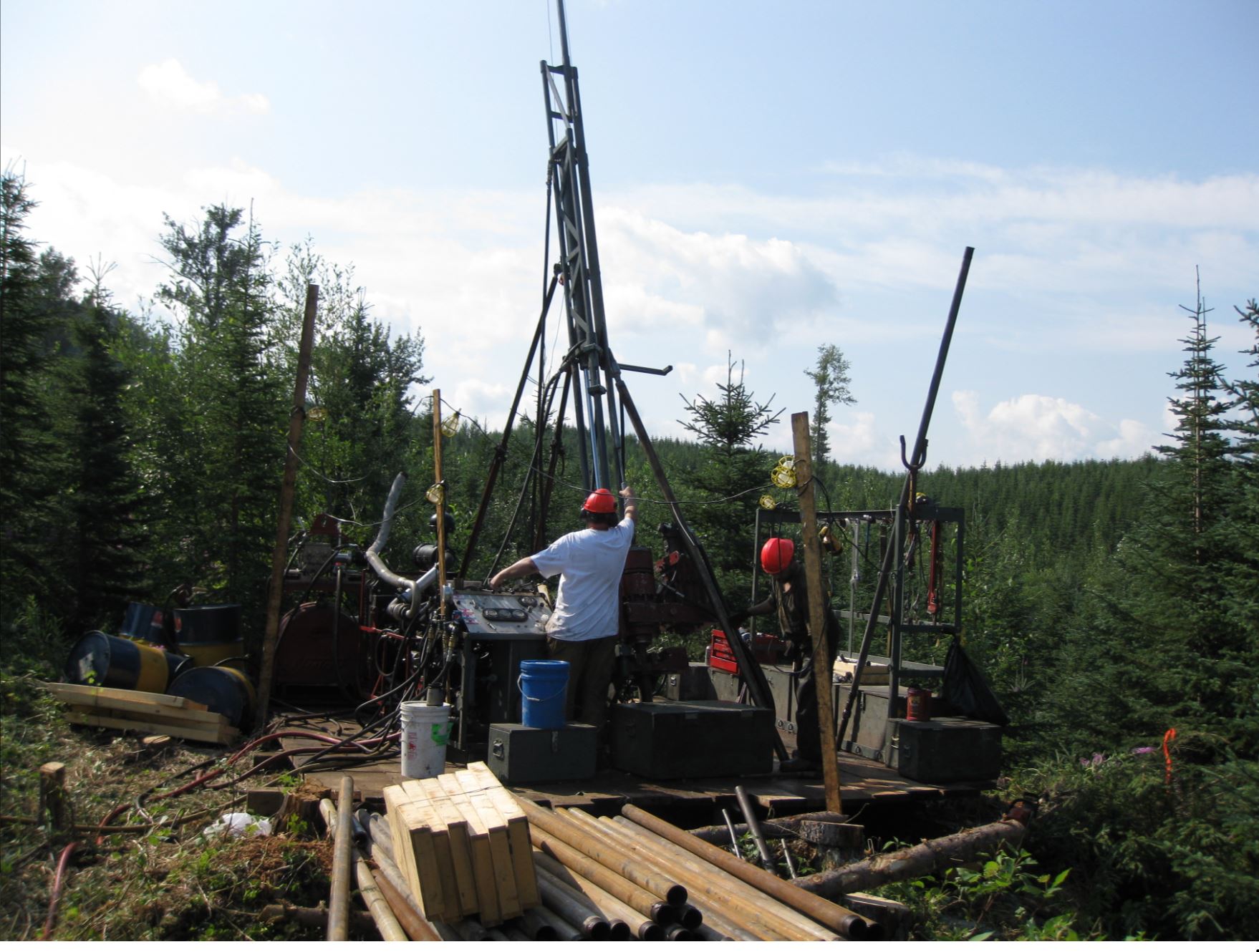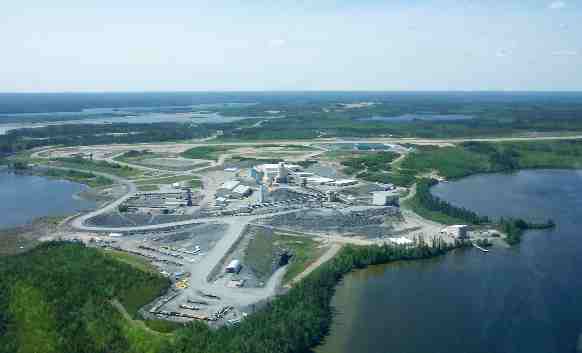Decarbonization: Countdown to net zero

Decarbonization has quickly become a top priority in the mining sector, and more and more miners are setting ambitious targets for reducing their carbon footprint. But the way forward is far from clear. A panel of industry experts at the Reimagine Mining Symposium discussed what really needs to happen to get to net zero.
The panel included Emily Thorn Corthay, founder and CEO of Thorn Associates; Mark Fellows, a co-founder and CEO of Skarn Associates; Brian Huff, VP technology and product line for Sandvik’s BHEV business unit; Luke Mahony, head of technology and innovation for Vale Base Metals; and Maarten van Koppen, VP product management with MacLean Engineering. The discussion was moderated by Canadian Mining Journal’s editor-in-chief Alisha Hiyate.
Mission possible?
With most of the major mining companies having already committed to achieving net zero Scope 1 and 2 emissions (direct and indirect emissions) by 2050, the conversation started by addressing how realistic that target is.
“If you ask: ‘Can we achieve the 2050 (goal)? I think we can,” said Vale’s Luke Mahony. “But we don’t know how.”
Mahony added that the interim 2030 goal that many miners have also committed to – which will see them slash emissions by a third by 2030 — is a key goal to getting there.
For most miners, the 2030 goal of a 33% reduction of absolute emissions is actually more ambitious than it seems. Under a business as usual scenario that considers declining grades and the startup of new operations, that 33% will likely become a 40% or a 50% reduction when you start to really break it down, Mahoney added.
The initial reductions will be easier to achieve: “Half of our initiatives to reach that 2030 goal are NPV (net present value) positive, they make sense,” Mahoney said. “It’s efficiency, it’s being more efficient in how you use your electrical equipment, it’s being more efficient from a process (standpoint).”
But once those initiatives are complete, he noted the incentive of a price on carbon will likely be needed to go further.
Investment in technology to capture carbon also needs to be accelerated for the future to get to net zero.
Emily Thorn Corthay of Thorn Associates noted that the Science Based Targets initiative (SBTi) has excellent guidance for companies on how to get started.
However, the guidance, which so far applies to Scope 1 and 2 emissions only, has changed over time and become more stringent. Initially, the SBTi targets allowed for maximum global warming of 2° Celsius, before being reduced to 1.7°. In July, the organization reduced that guidance further, to 1.5° Celsius.
“If (companies) can keep up with the SBTi, which very rapidly keeps getting more ambitious, that’s already very challenging for mining companies,” Corthay said. “If you can do that, you’re doing really well.”
In addition, SBTi targets need to be between five and 15 years in the future – meaning 2050 targets are not compliant with the initiative.
In order to align with the SBTi guidance to stay within a 1.5° Celsius maximum rise, companies need to reduce their emissions by around 42% between now and 2030, Thorn Corthay said.
“That’s generally possible on a corporate level – every site does not need to (achieve) that,” she said. “So I think mining companies can really strategically look at all of their assets, and choose which ones are easier to decarbonize. And then unfortunately, which ones eventually to potentially divest from.”
Mark Fellows of Skarn Associates added that while the 2050 goal is achievable, miners should be prepared for the major structural impediments that will arise.
“It’s easy to envisage how the equipment manufacturers’ order books are going to get pretty blocked out by the major mining companies as low-carbon mobile equipment becomes available,” he said. “There’s going to be a hell of a logjam when it comes to sourcing that equipment.”
Other issues include deciding what to do with operations that don’t have the mine life to justify the investment in a decarbonized mining fleet, or in grid power infrastructure.
“Those things are going to have a massive impact on the strategic position of various players within the industry. It is going to drive M&A, it’s going to drive financing,” Fellows said. “This is why our thesis for the last couple of years has been that the whole energy transition is going to be the big strategic driver of the mining sector for the next couple of decades.”
While the majors’ decarbonization commitments and challenges are currently in the spotlight, MacLean Engineering’s Maarten van Koppen pointed to opportunities for junior companies in the shifting landscape.
“Some of the more junior companies are already committing to net zero carbon products in the pretty near future,” he said. “The interesting thing is how that works out on the capital market where they’re all of a sudden able to attract investors that are not typically drawn to mining –
which is an opportunity in itself.”
Roadmap to decarbonization
Now that the direction toward net zero has been established, companies need to put together decarbonization roadmaps. The first step is for miners to understand their carbon footprint and have it verified by an independent third party, said Thorn Corthay.
After that, companies should complete a “business as usual” projection, followed by target setting. Then they should identify specific greenhouse gas abatement technologies for their roadmaps on a site-by-site basis, starting with assessing the viability of renewable energy.
“The number one enabler (for decarbonization) is renewable electricity. And if that’s not possible, that’s going to make it a lot more challenging,” Thorn Corthay said.
After renewable energy, electrification of transportation should be considered. In addition to electric vehicles, the replacement of diesel trucks with conveyor technology could be a solution.
“Simple cheap conveyors, they’re very proven technology,” she said. “When you can replace trucks with conveyors, that’s a really cost-effective option that’s available today.”
If those technologies can’t be implemented, mine sites can look at biodiesel, and in cold climates, heat recovery.
However, there is no one right path to decarbonization. Some companies, depending on their site conditions, might want to look at electrification of equipment before implementing renewable energy, said Sandvik’s Brian Huff.
“You can make some dramatic gains just from electrification,” he said. “In cold climates, you have to heat the air going into your mine. If you can get rid of a large number of diesel particulates underground, you can decrease your ventilation flow, and less ventilation flow requires less heating. So it’s a compounding benefit on the electrical energy usage.”
He added that some Sandvik customers have actually reduced their electricity consumption by converting to electric trucks because of the savings on heating costs.
“It’s a little bit counterintuitive — that you’re now powering your fleet by electric power, but consuming less net electricity for your mine site overall,” Huff said. “That step can be taken even before you start looking at renewables.” For most mines, fuel for trucks and loaders makes up 50% of their emissions, Huff noted, so electrification can go a long way toward decarbonation goals.
MacLean’s von Koppen said that even customers operating in jurisdictions without clean energy could benefit from electrification. Based on data provided by a customer that operates in a clean energy jurisdiction, the company did a “thought exercise” to see if there would still be carbon savings if they were to rely on a “dirty” diesel generator for power.
“Compared to the amount of diesel that they would have burnt on a diesel truck, it would still be three times cleaner to get the power for a BEV truck from a diesel generator rather than running the diesel engine,” he said. “Part of that is regeneration – it’s just inherent efficiencies within the (BEV) system,” van Koppen said. “So even if your power is super dirty, and you don’t have any ventilation savings, you can still cut back on your emissions significantly.”
That said, if the grid is powered by “dirty” energy, it will reduce the impact of conversion to battery electric trucks. Huff noted that conversion to BEVs at a mine in Canada will cut twice the emissions on average as conversion at a mine in the U.S., where the grid relies more heavily on coal.
Roadmaps are also going to evolve with technology.
After a comprehensive analysis looking at where their emissions come from and how they can be reduced, Vale identified four areas of focus, Mahoney said. Those were efficiency (especially as a lot of Vale’s emissions are on the processing side), low carbon power, heat recovery and fuel switching.
The hardest part is fuel switching, Mahoney said, because the technology is not there yet.
“For large trucks electrification and electrification of furnaces, it’s very expensive and it’s not as efficient compared to fossil fuels.”
As a transition, natural gas, biomass or bio carbon are possibilities, but they come with supply issues, he added.
Scope 3
The panel also discussed standardization of measurements and the measurement of Scope 3 emissions, which are generated upstream or downstream and therefore out of the direct control of the company.
Thorn Corthay and Fellows both noted that even with Scope 1 and 2, which are more straightforward to measure, there are irregularities and a lack of standardization in companies’ reported emissions.
“It’s quite indicative of the fact that everybody’s on a very steep learning curve,” Fellows said.
Thorn Corthay said that even though GHG reporting doesn’t yet carry the same rigour and penalties as a misreported earnings statement, companies should prepare for that eventuality. “You can bet on it – one day that financial rigour will come to the GHG accounting, so might as well get it as correct as possible.”
While Fellows says that his firm, Skarn Associates, measures emissions from the “rock in the ground through to refined metal,” investors are now asking for more – particularly if they produce inputs into steelmaking (iron ore and coal).
“The mining companies themselves are being held to account by investors for their Scope 3 emissions down into the steelmaking chain. And there’s a lot of quite complicated stuff going on there in terms of is the right iron ore product or met coal product going into the most appropriate steelmaking process, and to what extent is the miner responsible for that.”
Suppliers are starting to look at the emissions associated with their products as well, from steel to batteries: “The greenhouse gas emissions associated with the production of one of our batteries is completely offset by one month of operating on electric versus diesel,” said Sandvik’s Huff.
Last word
Mining companies currently have a lot of guidance on GHG reporting – including GRI Standards, SASB, Task Force on Climate-Related Financial Disclosures (TCFD) and SBTi – but conflicting reporting standards initiatives and bodies are making for a confusing “ESG spaghetti,” said Fellows.
While that is moving in the right direction – toward rationalization – the panellists warned against an overly dogmatic adherence to a reporting framework.
“The engineer inside of me wants to say that the over-emphasis on how to measure things exactly to the nth degree with all the different frameworks creates so much work that it kind of distracts sometimes from actually making a difference,” said MacLean’s van Koppen. “It’s interesting sometimes to see companies that are really precise at reporting how much carbon they have get rewarded in those types of indexes more than companies who focus that effort on making a difference.”
Vale’s Mahoney noted that frameworks are a good mechanism to provide consistency and help find the solutions needed for a net zero 2050 goal – as long as they are not too rigid and evolve with the wider sector.
“It’s the company policies, it’s industry support and collaboration, it’s suppliers and the whole ecosystem that needs to work together, and I think frameworks are just one part of that,” he said.





Comments